Delosperma
Delosperma N.E.Br.
Family: Aizoaceae
Common names: Afrikaans names of species: D. carolinense, D. vogtsii : klipvygie, rotsvygie; D. floribundum : skaapvygie; D. herbeum : witbergvygie; D. macellum : rooibergvygie
Introduction
This predominantly summer rainfall genus has long been overlooked as a garden plant. Growth forms vary vastly and showy flowers are produced over long periods, thus making them ideal rockery subjects, while some species form low, dense clumps and are more suitable as groundcovers in shady spots. Some species found naturally at higher altitudes can withstand northern hemisphere winters without having to be nurtured in a glasshouse.

Description
Description
The name of the genus is derived from the Greek words delos, visible, and sperma, seed, alluding to the capsules which have no covering membranes, thus exposing the seed once the capsules are open. However, covering membranes are reduced to a ledge in many species , a character that is not confined to Delosperma but is shared with the genus Trichodiadema (which can be easily distinguished by its 'crown of thorns' on the leaf tips).
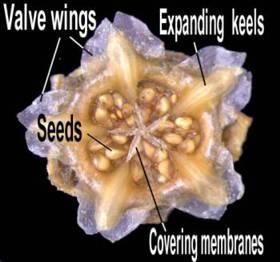
Delosperma plants are perennials and can be upright, procumbent, prostrate or even cliff-dwelling. They vary from woody to herbaceous and some even have thick, succulent root systems, while others root at the nodes. Leaves are sessile and vary from flat to cylindrical, the surfaces often grooved and covered with bladder cells or with bladder cells modified to form hairs.
Flowers are borne singly or in clusters and colours vary from white, cream, yellow, orange to various shades of pink and even crimson. Flower size varies greatly and some flowers can reach a diameter of 40 mm ( D. sutherlandii ). Glands are separate.
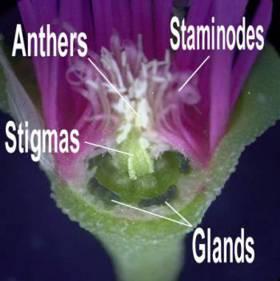
Flowering times are from August to January, depending on rainfall. The plants often flower sporadically throughout the season if rainfall persists. Flowers open at midday and close again in the late afternoon, but on overcast days they tend to remain closed.
Most Delosperma species are self-compatible where as many other mesemb genera are not, thus only one Delosperma plant can still ensure seed production. Capsules ripen, dry and open to release seed by wetting, a process known as hydrochasty. This is a unique mesemb character and is one of the secrets of the success of the family in southern Africa (Parolin 2001). Though lacking covering membranes, capsules of Delosperma have prominent valve wings and diverging, expanding keels but no closing body (see image of capsule above). Seeds are normally shorter than 1 mm and germinate readily. Delosperma plants may live up to 20 years if treated appropriately.
Conservation Status
Status
Since its establishment as a genus by N.E. Brown (1925), Delosperma has not been revised and is in desperate need of taxonomic attention (Chesselet et al. 1995). Mary O'Connor-Fenton (née Lavis) attempted a revision but her death in 1992 prevented her from completing it. The genus currently comprises approximately 170 species. A few have been Red-listed ( Pfab & Victor 2002; Burgoyne & Victor 2003) but most species are plentiful in habitat. Many of them are known only from the type locality and thus many taxa have a Red List status as Data Deficient.
Distribution and habitat
Distribution description
This genus is confined to Africa and neighbouring islands, with most species widespread throughout the central parts of the summer rainfall region of southern Africa (currently 162 species). It is one of the few mesemb genera extending northwards into Africa (five species) and it is also represented in the Arabian Peninsula (one species). Two species occur outside the African continent: one on Madagascar and one on the island of Réunion.
Ecology
Ecology
Almost all habitats from seashore to forest are colonized, making it an excellent garden plant as there are species for almost every garden niche. Altitude varies from sea level to the highest mountain peaks, with particular species richness in the Eastern Cape. Adaptations by members of this genus include leaf succulence, which helps to retain water in times of drought. Thick roots are found in species that inhabit areas frequently burned, enabling them to survive fire. Delosperma is a predominantly grassland genus, but cannot compete with grasses and other herbs and the plants therefore thrive in rocky habitats where competition with other species is less fierce. These habitats include spots with shallow, poor soils or rock crevices where temperatures are often high. Rainfall above 300 mm is critical for survival of the plants and only two species are found in the more arid areas of southern Africa.
Pollination of members of this genus is complex and many visitors have been observed.

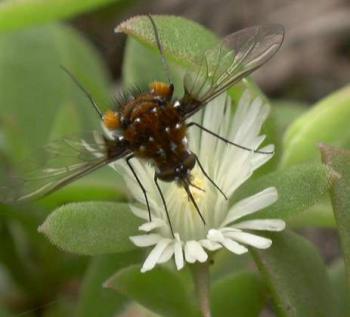
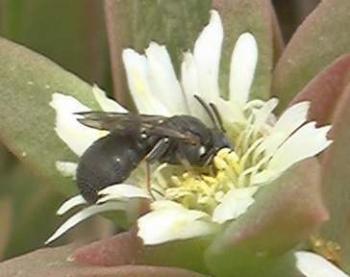
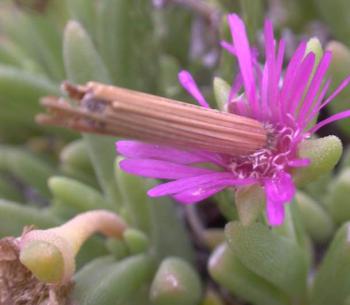
The author has observed that the common grey lourie finds the leaves of Delosperma cooperi very tasty and feasts on them in winter when little else is available. The plants do recover.
Uses
Use
Apart from the horticultural trade, this genus is important in KwaZulu-Natal where it is one of the group of plants called intelezi and used to bring good luck. Some species are used as magical plants to give those in possession of them powers to know in advance what their enemies are planning; one member of this diverse group of plants is D. saturatum. Zulu warriors going to war would grind up the dried plants, adding them to the water with which they washed their bodies and their weapons.

Growing Delosperma
Grow
In the garden Delosperma is a genus with huge garden potential as the perennial plants require very little maintenance. Plants can be sown from seed, which germinates readily and has to be thinned out. Cuttings root readily and can form a groundcover within a short period. Although they are succulent, Delosperma plants originate from summer rainfall areas and therefore need plenty of water. Treating them like other succulents with limited watering will cause their untimely death.
The most commonly commercially available Delosperma is D. cooperi, which forms low, dense mats. Coming from areas of high altitude, this species can withstand frost and produces large, bright pink flowers throughout the summer season.
A popular groundcover in the northern hemisphere is D. nubigenum, which also forms a low, dense mat and produces bright yellow flowers. As it is adapted to withstand the harsh winters of Lesotho, it can be planted out of doors in northern hemisphere gardens.
Species

D. cooperi is the most commonly commercially available species and grows naturally at higher altitudes in central southern Africa. It thrives in sun and shade.
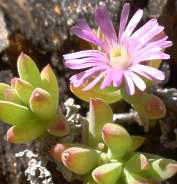
Coastal species include D. patersoniae, which can have really robust leaves when growing further to the south. Flower colour in this species varies from white to apricot and pink.
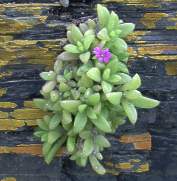
Another coastal species is D. stenandrum, which has bright pink flowers, attractive hairy leaves and thrives in gardens away from the coast.

D. gratiae occurs further inland on the Eastern Cape mountains and is a mat-forming species that grows well in direct sun. The pale pink flowers are borne at intervals throughout the summer.
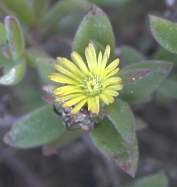
D. lebomboense, also a mat-forming species, has white flowers, flat leaves and prefers shade. Similar species that fare well as groundcovers in shade are D. tradescantioides with deep pink flowers, D. jansei with white flowers and hairy leaves, D. pallidum and D. velutinum with white or pale pink flowers. D. rogersii, also mat-forming, has yellow flowers.
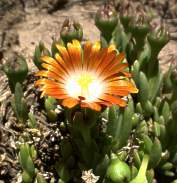
D. dyeri, recently rediscovered (Dold & Hammer 2001) on mountains of the Eastern Cape, has a compact growth form and large flowers in shades of orange, making it an excellent rockery plant.
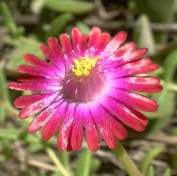
D. dyeri var. laxum described by Louisa Bolus from Tarkastad is considered as the most splendid taxon in the genus.
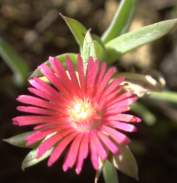
D. acuminatum from the Albany District has a thickened rootstock and the flowers are shades of red to deep orange. This species thrives on very little water and tends to become lax in gardens as over-watering produces much growth.
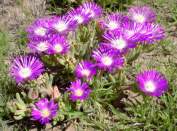
D. floribundum, from the flats near Kroonstad, is one of the most attractive species and in season can turn the landscape pink when in flower. It grows in disturbed sandy spots, produces large flowers and large quantities of seed and has vast potential as a garden plant.
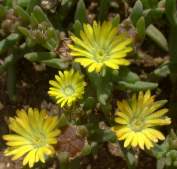
D. leendertziae, endemic to Gauteng, forms compact plants producing small, yellow flowers throughout the season from September to May.
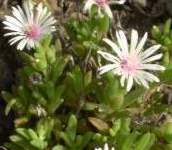
D. macrostigma occurs in the southern Cape near Swellendam and forms upright clumps with pale pink flowers.
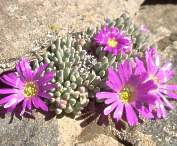
D. sphalmanthoides from the Sutherland area is the smallest species in the genus and has large pink flowers, but does not do well as a garden plant.
References
- Brown, N.E. 1925. Mesembryanthemum and some new genera separated from it. Gardener's Chronicle 78: 412.
- Burgoyne, P.M. 2003. Delosperma from central southern Africa - a call to collectors. PlantLife 29: 8 -14.
- Burgoyne, P.M. & Smith, G.F. 1998. Preparing useful herbarium specimens of succulents and other plants with fleshy parts. Aloe 35: 102, 103.
- Burgoyne, P.M. & Victor, J.E. 2003. Delosperma : taxonomic notes and proposed Red List status of certain species. Aloe 40: 93 -97.
- Chesselet, P., Mössmer, M. & Smith, G.F. 1995. Research priorities in the succulent plant family Mesembryanthemaceae Fenzl. South African Journal of Science 91: 197 - 209.
- Dold, T. & Hammer, S.A. 2001. Dyer's Delosperma rediscovered. Cactus and Succulent Journal ( US ) 73,2: 73 - 75.
- Parolin, P. 2001. Seed expulsion in fruits of Mesembryanthema (Aizoaceae): a mechanistic approach to study the effect of fruit morphological structures on seed dispersal: Flora 196: 313-322.
- Pfab, M.F. & Victor, J.E. 2002. Threatened plants of Gauteng, South Africa. South African Journal of Botany 68: 370-375.
Credits
Priscilla Burgoyne
National Herbarium Pretoria
October 2005
Plant Attributes:
Plant Type: Succulent
SA Distribution:
Soil type:
Flowering season:
PH:
Flower colour:
Aspect:
Gardening skill:
Special Features:
Horticultural zones






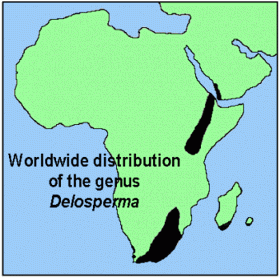
Rate this article
Article well written and informative
Rate this plant
Is this an interesting plant?
Login to add your Comment
Back to topNot registered yet? Click here to register.